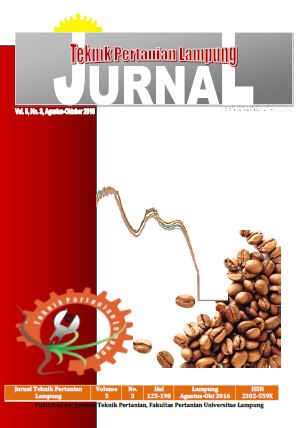ANALISIS DIFUSI LARUTAN PUPUK MELALUI DINDING MORTAR ARANG SEKAM PADI
Abstract
The aim of this reasearch is to determine difussion coefficient of nutrient solution through rice husk charcoal
mortar walls. This research used completely randomized design (CR) with factorial arrngement which consisted
of factors. The first factor, the material composition ratios of mortars (cement : sand : rice husk charcoal),
consisted of two levels: P 1 (1:3:3) and P 2 (1:3:4). The second factor, the concentration of nutrient consisted of
ree levels, namely K 1 (3 mS/cm), K 2 (6 mS/cm), and K 3 (9 mS/cm). Data set was analyzed by using ANOVA,
then followed by using LSD at 5% significant level. Anova showed that there was interaction between mortar
material composition and nutrient concentration. The best diffusion coefficient was found in the treatment P 2 K 1
and P 2 K 2 (1:3:4 and the nutrient concentrations 3 mS/cm, 6 mS/cm). Nutrient solution in the treatments could
pass through the walls of mortar very well, so that it could be used as a means of fertigation.
Keywords: Fertigation, Diffusion, Nutrient Solution, and Rice Husk Charcoal Mortar.
Downloads
Published
Issue
Section
License
- Authors who publish with this journal agree to the following terms:
- Authors retain copyright and grant the journal right of first publication with the work simultaneously licensed under a Creative Commons Attribution-ShareAlike 4.0 International Lice that allows others to share the work with an acknowledgement of the work's authorship and initial publication in this journal.
- Authors are able to enter into separate, additional contractual arrangements for the non-exclusive distribution of the journal's published version of the work (e.g., post it to an institutional repository or publish it in a book), with an acknowledgement of its initial publication in this journal.
- Authors are permitted and encouraged to post their work online (e.g., in institutional repositories or on their website) prior to and during the submission process, as it can lead to productive exchanges, as well as earlier and greater citation of published work (See The Effect of Open Access).
Jurnal Teknik Pertanian Lampung

JTEPL is licensed under a Creative Commons Attribution-ShareAlike 4.0 International License.

